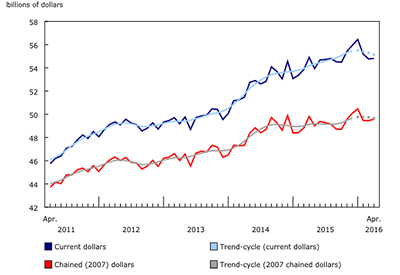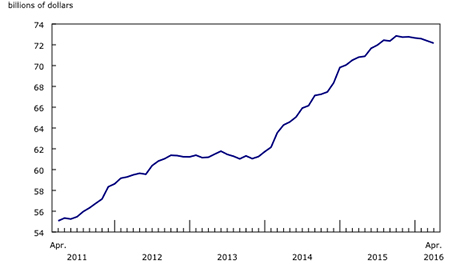Wholesale Sales Edge Up in April

July 5, 2016
Wholesale sales edged up 0.1% to $54.8 billion in April, after two consecutive monthly declines. Gains were recorded in three of seven subsectors, led by the miscellaneous subsector. In volume terms, wholesale sales increased 0.2%.
Higher sales in three subsectors
The miscellaneous subsector recorded the largest gain in dollar terms in April, up 5.2% to $7.1 billion. The other miscellaneous industry (+12.6%) accounted for most of the gain, rising for the first time in three months and reaching its highest level since August 2011. This industry comprises establishments, not classified to any other industry group, primarily engaged in wholesaling logs, wood chips, minerals, ores and concentrates, precious metals, second-hand goods and other products.
Sales in the food, beverage and tobacco subsector rose 0.7% to $10.6 billion, after two months of declines. Higher sales in all three industries contributed to the gain.
The personal and household goods subsector recorded a third consecutive gain, rising 0.7% to a record high of $8.0 billion. Four of six industries posted increases, with pharmaceuticals and pharmacy supplies contributing the most to the advance.
Sales in the machinery, equipment and supplies subsector fell 1.9% to $10.9 billion in April. Decreases recorded in the computer and communications equipment and supplies industry (-3.3%) and the construction, forestry, mining, and industrial machinery, equipment and supplies industry (-3.0%) accounted for most of the decline.
The building material and supplies subsector decreased for the fourth consecutive month, down 2.0% to $7.3 billion, with all industries contributing to the decline.
Sales increase in four provinces
Wholesale sales were up in four provinces in April, led by British Columbia. Gains were partially offset by lower sales in other provinces, led by Quebec.
Sales in British Columbia rose 4.4% to $5.5 billion, their first increase in three months. Gains were led by the miscellaneous subsector and the motor vehicle and parts subsector.
Following three consecutive monthly declines, sales in Saskatchewan rose 6.6% to $1.9 billion in April. Gains were widespread, led by the miscellaneous subsector.
In Newfoundland and Labrador, sales grew 24.5% to $419 million, on the strength of gains in all subsectors, led by the miscellaneous subsector. The food, beverage and tobacco subsector contributed to higher sales in New Brunswick, where sales were up 1.8% to $544 million. This was the third consecutive gain for both provinces.
In dollar terms, Quebec and Ontario recorded the largest declines in April. Sales dropped 1.9% to $9.9 billion in Quebec, as a result of widespread decreases across the subsectors, while sales in Ontario fell 0.5% to $28.1 billion, led by lower sales in the machinery, equipment and supplies subsector and the motor vehicle and parts subsector.
In Alberta, sales decreased 0.6% to $6.2 billion, led by lower sales in the machinery, equipment and supplies subsector. In Manitoba, sales were down 1.4% to $1.4 billion, with the farm product subsector contributing the most to the decline. In both provinces, gains recorded in March were partially offset by declines in April.
Sales in Nova Scotia fell 1.2% to $765 million in April, a fourth consecutive decline.
In Prince Edward Island, sales declined 2.8% to $56 million, a third consecutive decrease.
Inventories down in April
Wholesale inventories edged down for a fourth consecutive month in April, decreasing 0.3% to $72.2 billion, the lowest level since July 2015. Declines were recorded in four of seven subsectors, together representing 76% of wholesale inventories.
Chart 2: Wholesale inventories down in April
The miscellaneous subsector (-3.9%) recorded the largest decrease in dollar terms, declining for the fourth time in seven months and bringing the subsector to its lowest level since April 2015.
Inventories in the machinery, equipment and supplies subsector (-0.8%) declined for the fifth time in six months.
Lower inventories were also reported by the building material and supplies subsector (-0.6%) and the personal and household goods subsector (-0.3%).
Following four consecutive declines, the motor vehicle and parts subsector (+3.3%) posted the largest increase, bringing inventories in the subsector to their highest level on record.
The inventory-to-sales ratio was unchanged at 1.32 in April. This ratio is a measure of the time in months required to exhaust inventories if sales were to remain at their current level.
Source: Statistics Canada, www.statcan.gc.ca/daily-quotidien/160620/dq160620a-eng.htm.












